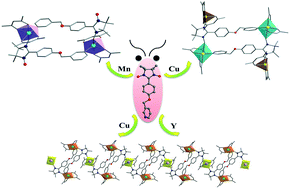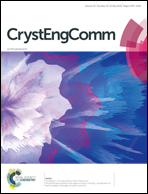A functional nitroxide ligand builds up two 2p–3d complexes with different spin ground states and a 2p–3d–4f chain of rings†
Abstract
Three new metal complexes derived from a functional nitronyl nitroxide ligand, 2-(4-(3-pyridinylmethoxy)phenyl)-4,4,5,5-tetramethyl-imidazolyl-1-oxyl-3-oxide (NIT-3PyPh) and M(hfac)2 or/and Y(hfac)3 (M2+ = Cu2+, Mn2+; hfac = hexafluoroacetylacetonate), [(Mn(hfac)2)2(NIT-3PyPh)2] (1), [(Cu(hfac)2)4 (NIT-3PyPh)2] (2) and [Y(hfac)3{Cu(hfac)2(NIT-3PyPh)}2] (3) have been synthesized and characterized. 1 is a four-spin complex with a dimeric structure, whereas 2 consists of a six-spin ground state, which includes a cyclic molecular structure with two Cu(hfac)2 units linked by free NO groups. Complex 3 consists of a one-dimensional chain in which the Y(hfac)3 molecules bridge the dimeric [Cu(hfac)2(NIT-3PyPh)]2 units. Magnetic studies show that complex 1 exhibits a strong antiferromagnetic (AFM) coupling between the MnII ion and directly bonded nitroxide and weak ferromagnetic (FM) interaction between the two Mn–NIT pairs. For complex 2, the FM and/or AFM interaction depends on the axial or equatorial type of coordination of the NO group. The AFM interactions are dominant in complex 3, due to the strong radical–radical AFM exchange interactions through the YIII ion.



 Please wait while we load your content...
Please wait while we load your content...